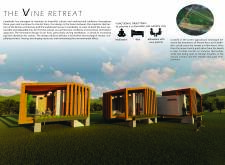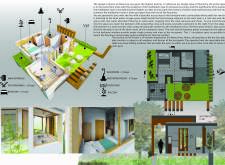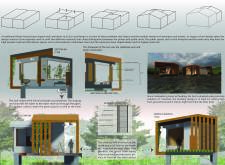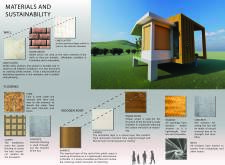5 key facts about this project
The Vine Retreat combines elements of traditional Khmer architecture and modern minimalist design. Located in the agricultural landscape between the mountains of Phnom Vour and the south coast of Cambodia, the retreat serves as a space for meditation and relaxation. With a focus on sustainability and improving the visitor experience, the design organizes spaces to support both functionality and tranquility.
Spatial Organization
Simplicity and ecological awareness shape the overall concept. The retreat is designed primarily with single-story configurations, featuring an elevated meditation area that highlights its significance and provides privacy. This separation from the more public spaces in the retreat allows for a peaceful setting, essential for reflection and mindfulness.
Integration of Outdoor Spaces
Outdoor areas are considered extensions of the indoor living environment. Each hut includes front yards where retractable dining tables invite occupants to enjoy nature. The layout incorporates bamboo plants and thoughtfully positioned roofs for shade and privacy, enriching the connection between the huts and the surrounding landscape.
Roof Configuration and Sustainability
The roof design reflects traditional Khmer styles with sloped heights that distinguish between public and private areas. Public spaces have higher wooden roofs, providing an open feeling, while private spaces maintain a lower profile to encourage intimacy. Additionally, the design effectively channels rainwater into a reservoir for reuse, reinforcing a commitment to sustainable practices.
Material Choices
Materials selected for the retreat are locally relevant and sustainable. Lime plaster is used for durable interior finishes, while adobe bricks form the primary walls, known for their ecological benefits. Cork flooring manages moisture in key entry points, and concrete ensures structural strength throughout. The roof utilizes timber wood for its aesthetic and functional properties, while canvas aids in temperature control, and bamboo weave functions as adjustable shutters, promoting airflow and blending with the environment.
Soft, filtered light comes through the bamboo shutters, creating calming patterns on the walls and enhancing the retreat's tranquil atmosphere.






















































